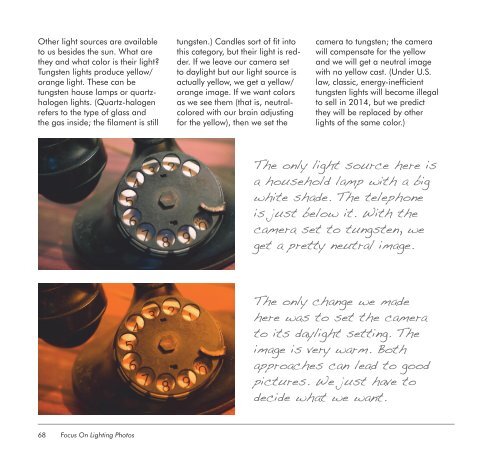Focus On Lighting Photos Focus on the Fundamentals.pdf
You also want an ePaper? Increase the reach of your titles
YUMPU automatically turns print PDFs into web optimized ePapers that Google loves.
O<strong>the</strong>r light sources are available<br />
to us besides <strong>the</strong> sun. What are<br />
<strong>the</strong>y and what color is <strong>the</strong>ir light?<br />
Tungsten lights produce yellow/<br />
orange light. These can be<br />
tungsten house lamps or quartzhalogen<br />
lights. (Quartz-halogen<br />
refers to <strong>the</strong> type of glass and<br />
<strong>the</strong> gas inside; <strong>the</strong> filament is still<br />
68<br />
<str<strong>on</strong>g>Focus</str<strong>on</strong>g> <str<strong>on</strong>g>On</str<strong>on</strong>g> <str<strong>on</strong>g>Lighting</str<strong>on</strong>g> <str<strong>on</strong>g>Photos</str<strong>on</strong>g><br />
tungsten.) Candles sort of fit into<br />
this category, but <strong>the</strong>ir light is redder.<br />
If we leave our camera set<br />
to daylight but our light source is<br />
actually yellow, we get a yellow/<br />
orange image. If we want colors<br />
as we see <strong>the</strong>m (that is, neutralcolored<br />
with our brain adjusting<br />
for <strong>the</strong> yellow), <strong>the</strong>n we set <strong>the</strong><br />
camera to tungsten; <strong>the</strong> camera<br />
will compensate for <strong>the</strong> yellow<br />
and we will get a neutral image<br />
with no yellow cast. (Under U.S.<br />
law, classic, energy-inefficient<br />
tungsten lights will become illegal<br />
to sell in 2014, but we predict<br />
<strong>the</strong>y will be replaced by o<strong>the</strong>r<br />
lights of <strong>the</strong> same color.)<br />
The <strong>on</strong>ly light source here is<br />
a household lamp with a big<br />
white shade. The teleph<strong>on</strong>e<br />
is just below it. With <strong>the</strong><br />
camera set to tungsten, we<br />
get a pretty neutral image.<br />
The <strong>on</strong>ly change we made<br />
here was to set <strong>the</strong> camera<br />
to its daylight setting. The<br />
image is very warm. Both<br />
approaches can lead to good<br />
pictures. We just have to<br />
decide what we want.



